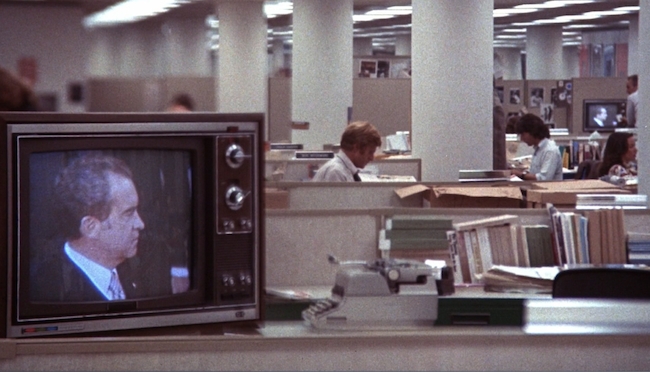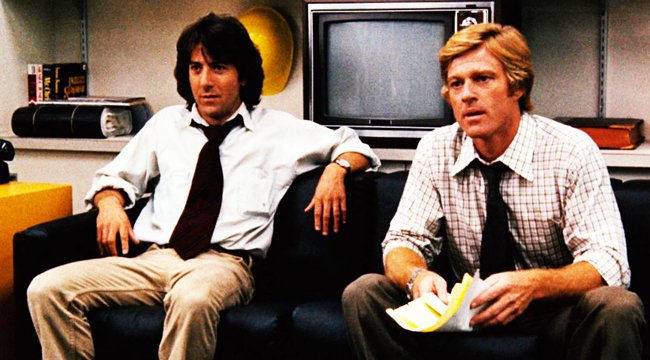
All the President’s Men is a 1976 movie, based on the book of the same name, that follows Washington Post reporters Bob Woodward and Carl Bernstein as they unravel the Watergate conspiracy and trace it up into and through the Nixon administration. The film opens with the break-in itself and then slowly reveals how it was all tied into shady campaign tactics and misuse of campaign funds that led to the appointment of a special prosecutor and multiple former or current administration figures pleading guilty to felonies and I decided to rewatch it this week for no reason in particular.
Nope, no real reason at all. Just hadn’t seen it in a while and thought it would be fun. Why, is there a reason that watching it this week could have been relevant? Huh. Yeah, I don’t know. I’ve been pretty busy. Haven’t been keeping up with the news. Good movie, though.
The time has come to talk about All the President’s Men.
1. The cool thing about All the President’s Men is that it’s structured almost like a 1980s buddy cop movie. Robert Redford plays Bob Woodward as the smooth, calmer, more straightlaced reporter. Dustin Hoffman plays Carl Bernstein as the wild hotshot reporter who smokes in elevators and plays a little fast and loose with the rules but gets results, dammit. Hell, there’s even a scene where their boss (Jason Robards as Washington Post editor Ben Bradlee) threatens to take them off the story. You’ve seen these characters in 100 movies in the 40 years since this one and you’ll see it 100 times in the next 40 years, too. There’s a reason for that: the formula works. The only thing missing was, like, Haldeman cornering the reporters near the end and explaining that he was “not so different” from the two of them, really. Maybe I watch too many buddy cop movies. That’s a possibility, too.
2. There’s a thing people do when they talk about older movies, where they discuss if the movie “holds up” today. I try to avoid doing that because good movies usually just stay good and a movie that doesn’t hold up probably wasn’t that good in the first place. (The exception here is when a “good” movie becomes horribly dated through its use of, oh, let’s say “non-preferred” language or behavior toward groups of people. That’s a different discussion, though.) But if you box me in and force me to have this discussion, then yes, All the President’s Men definitely holds up.
It’s a pacing thing, mostly. Pacing and suspense. The film clocks in north of two hours and is loaded with the types of long scenes that were common for filmmaking of the era, but it doesn’t really drag. There’s a linear progression to it that is captivating. They find a source. Cool. But it’s not enough. So they follow that lead to another source. Cool. Still not enough. They meet with shady secret sources in parking garages and fly to Florida and California. Cool. Getting there. They use fun mental gymnastics to get sources to reveal information, like tossing off a casual mention of a name like they have it confirmed and then letting the source’s agreement serve as the real confirmation. It moves the entire time, step-by-step, and remains super-rewatchable all these years later.
It’s a mystery. It’s two little guys going after a big guy and winning. Who the hell doesn’t love that kind of story? Even if you already know how it ends.
3. The one thing I will say about the 1970s of it all is, man, there is a lot of paper in this movie. Look at Woodward’s apartment.
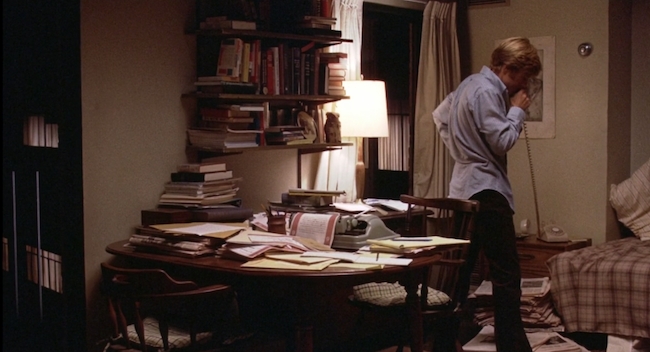
I’m not sure a nation of people staring at tiny handheld computers for 18 hours a day is much of an improvement, but it is incredible to me that anyone ever got anything done in under those circumstances. There’s a scene in this movie where Woodward and Bernstein go to the Library of Congress to look through book requests. They spend hours flipping through slips of paper looking for one name. Today, that’s a 20-second CTRL+F. It’s insane how much easier that is. You could do that and still have the rest of your afternoon free. You could get in an entire round of golf if you wanted. This is why people are so angry at Millennials all the time.
4. Remember the thing I said earlier about long scenes? At one point in the movie, right when they’re starting to uncover the potential misuse of campaign funds and how they were used to cover-up certain illicit activity, which I mention only to point out its relevance to the scene in question and not because it has anything to do with current events here in 2018 as far as I know (again, very busy), there’s a six-minute one-shot of Robert Redford making phone calls. It’s a really great scene, especially as you start to realize that there are no cuts, and I would have a lot more to say about it if I had been able to focus on anything other than Robert Redford‘s hair.
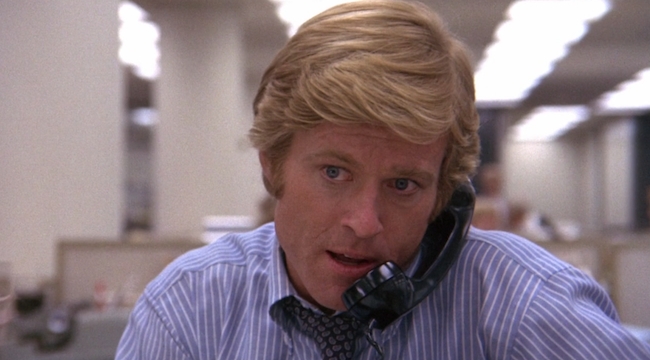
My word, what a terrific head of hair that man has. And I do mean “has,” present tense. Go look at a current picture of him. The man is in his 80s and his hair still looks exactly like that, just with a few gray streaks layered through it. It’s… it’s a little infuriating, to be honest. The guy is an on-screen icon, a behind-the-scenes legend, a recipient of the Presidential Medal of Freedom, a humanitarian, and a champion of independent film, and he has a head of hair like a freaking teen idol. It’s too much. It’s entirely too much. Not even Clooney has the hair. Come on, guy.
5. This is my favorite shot in the movie.
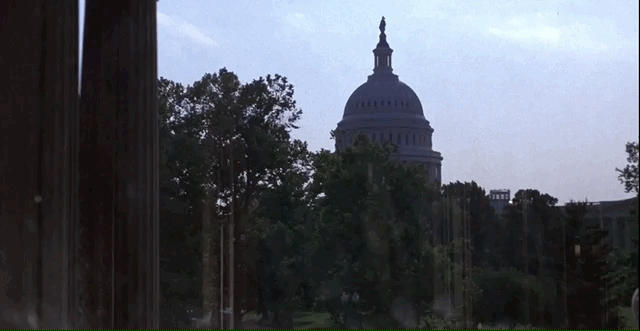
I love it because it’s not necessary to frame it like that. Director Alan J. Pakula could have just gotten them rushing out the door and moved on. And it also seems like something they just noticed on set, like “Hey, if we put the camera over here…” and then they did it because it looked cool. I support almost all spontaneous decisions made with the rationale of “I dunno. Because it’s cool?”
6. At one point in the movie, after Woodward and Bernstein take a story to print that was factually correct but left a little to be desired with nailed-down, named sources, the action cuts in real footage of Nixon’s press secretary blasting the Washington Post for “shabby journalism” and hypocrisy and railing against editor Ben Bradlee for his liberal bias. Doesn’t really have anything to do with anything, I suppose, but I found it interesting how the Nixon administration had such an adversarial relationship with the press and then we all learned our lesson and that never happened again. Wait. Why are you looking at me like that? You look angry. I feel like I’ve upset you. Hmm. Let’s move on.
7. Ben Bradlee was a fascinating guy in real life and I urge you all to look him up at some point. Jason Robards steals every scene he’s in as Bradlee, all swagger and command and gusto. We could talk about the finer points of his performance to elaborate on this, but I think the more effective way to get this across is to point out how often he has his feet up on desks or tables in the movie.
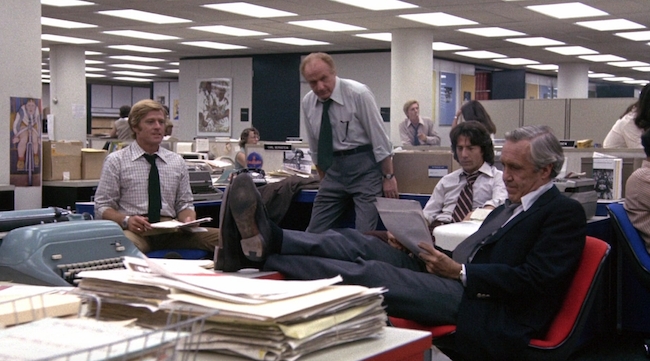
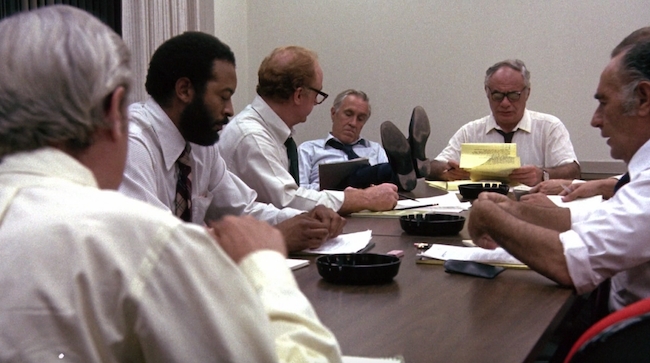
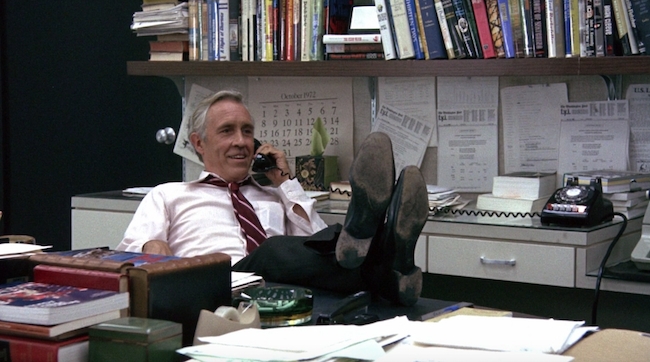
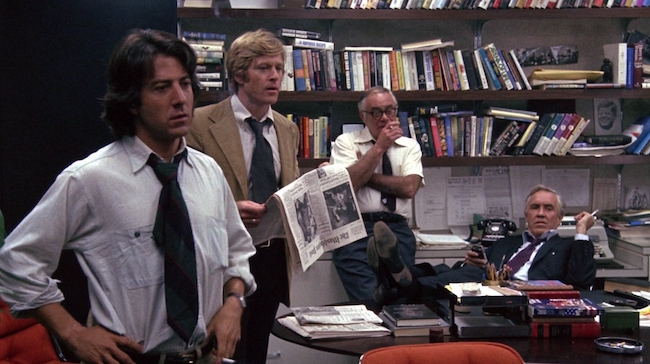
High degree of difficulty on that move. Easy to come across like a self-important doofus. The fact that he pulls it off this many times says a lot about the performance and the real man.
8. Speaking of things to look up when you have a few minutes… uh, take a trip down the entire Watergate rabbit hole some time. It’s wild down there. Like, the thing in the movie where former Attorney General John Mitchell warns Bernstein that running a particular story would result in Washington Post owner Katherine Graham getting “her tit caught in a big wringer”? Happened. Swear to God. And then, when you’re looking into John Mitchell, click over to read about his wife, Martha. Read about Martha Mitchell. I’m not going to get into it here because I’m trying to focus on the movie and not tumble too far down into the history because if I do I’ll never get back to the surface, but yeah. If you think politics are crazy today, as I assume they are and will look into very soon (I promise), please be comforted or terrified by the fact that American politics have always been insane.
9. I lied. I am going to get into it. Martha Mitchell was a talker who loved talking, especially to reporters, even though her husband was the head of Nixon’s re-election campaign. From the New York Times:
It was not unusual for Mrs. Mitchell to telephone a reporter late at night and tell what was on her mind. In one such call to The New York Times in March 1973, she said that she thought somebody was trying to make her husband “the goat” for the Watergate scandal and that she was “not going to let that happen.”
That’s strange. It gets stranger.
Mrs. Mitchell had complained that on the weekend the Watergate break‐in was discovered in June 1972, she was being held as a “political prisoner” at the Newport Inn at Newport Beach, Calif. She had also contended that she had been given injections and held in her room against her will by Steve King, a security official.
This was later confirmed by James W. McCord Jr., a convicted Watergate conspirator who was Mr. Mitchell’s bodyguard before he became chief, of security for President Nixon’s re‐election campaign. Mr. McCord said Mrs. Mitchell was “basically” kidnapped in 1972 to keep her ignorant of the Watergate break‐in.
Read about Watergate. And/or listen to season one of the Slow Burn podcast.
10. The movie actually throws out the last half of the book, with William Goldman’s script ending before the investigation really starts causing problems for Nixon. It doesn’t get to his tapes, or the Saturday Night Massacre, or his resignation, choosing instead to end on a montage of guilty pleas of the conspirators spitting out of a teletype machine. There is a great moment right before that, though. It’s another long single shot, this time of the newsroom, with Woodward and Bernstein clacking away at their typewriters as Nixon recites the Oath of Office at his inauguration. Symbolism!
Now, if you’ll excuse me, I really should get caught up on current events here in 2018. Let me just take a big sip of this coffee and click over to see what’s in the news…
